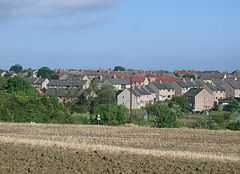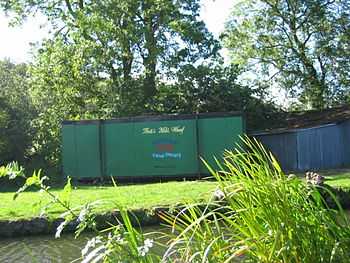Winchburgh
| Winchburgh | |
 Winchburgh, viewed from the south |
|
 Winchburgh |
|
| OS grid reference | NT086750 |
|---|---|
| Civil parish | Kirkliston |
| Council area | West Lothian |
| Lieutenancy area | West Lothian |
| Country | Scotland |
| Sovereign state | United Kingdom |
| Post town | BROXBURN |
| Postcode district | EH52 |
| Dialling code | 01506 |
| Police | Scottish |
| Fire | Scottish |
| Ambulance | Scottish |
| EU Parliament | Scotland |
| UK Parliament | Livingston |
| Scottish Parliament | Linlithgow |
Coordinates: 55°57′35″N 3°27′51″W / 55.9597°N 3.4642°W
Winchburgh is a village in the Council area of West Lothian, Scotland. It is located approximately 10 miles (16 km) west of the city-centre of Edinburgh, 6 miles (9.7 km) east of Linlithgow and 3 miles (4.8 km) northeast of Broxburn.
Population
The 2001 census recorded around 2,000.[1]
Public transport
There are regular scheduled buses to and from surrounding places including Edinburgh, Linlithgow, Falkirk, South Queensferry and Broxburn. Buses following Route number 38 travel to and from Edinburgh to Linlithgow/Falkirk/Stirling, via Winchburgh. The weekend night bus service, Route number 44N, follows a similar route, allowing travellers to return from Edinburgh City Centre at 12.30am and 3.00am on Saturdays and Sundays.
The mainline railway between Edinburgh and Glasgow Queen Street goes through the Winchburgh Tunnel, under the village. Until it was closed in 1930, there was a passenger station at the north end of the tunnel. The construction of the Winchburgh Tunnel was supervised by the noted Scottish Civil Engineer, John Gibb.
Sport
Niddrie Castle Golf Club has an 18-hole, 5914 yards long, par 70 golf course, located in and around the grounds of the historic Niddry Castle. The club was established in 1926.
Winchburgh Bowling Club was established in 1913 by local miners and the clubhouse has a 150-capacity function room for social occasions, such as weddings.
In July 2007, parents from local schools formed a boys' football, taking the name of the former Winchburgh Albion, which had folded in the 1970s. The club now has a team playing in the West Lothian Association of Youth Football Clubs league, at the Under-14 age level. The club was promoted to the A League in the 2008/09 season, as Runner-Up. Burgoyne finished as the club's top scorer with 21 goals.
The original Winchburgh Albion FC had produced several senior football players, including Willie Thornton (1920 - 1991), who had a long career with Rangers as player and later, Assistant Manager, after managing Dundee and Partick Thistle. John Gorman is another former Winchburgh Albion FC player. He started his senior career with Celtic, before going on have playing success with Carlisle, Tottenham Hotspur and as a coach with several clubs, including his present role at MK Dons. He was also assistant manager of the England international team, from 1996 to 1999, under the management of Glenn Hoddle.
Amenities
There is a small number of convenience store sized shops, a pharmacy, a doctor's surgery, a post office and a Community Centre. Housing ranges from late-19th Century brick built cottages (purpose-built to house miners & their families) to modern social housing in the forms of houses, cottages and flats. There is also sheltered housing for elderly residents, as well as an elderly care home within the village.

Winchburgh and the Union Canal
The Edinburgh to Falkirk Union Canal passes through Winchburgh. It follows a contour south to Broxburn and eventually Edinburgh. Westwards it goes through Linlithgow, and then Falkirk. The Union Canal was used in the past to transport goods between places situated in and between Edinburgh and Glasgow - there was a connection with the Forth and Clyde Canal at Falkirk. The Bridge 19-40 Canal Society has a base at Winchburgh on the canal, and it operates seasonal boat trips departing from Port Buchan located in neighbouring Broxburn on West Main Street.
Schooling
The village has two primary schools and a nursery located in Winchburgh. The 'Holy Family Primary' school serves Roman Catholic (term) pre-secondary school children, whereas 'Winchburgh Primary' is a non-denominational school. Both of these are state run schools, and share the same building (the Holy Family Primary School's original building was demolished). Secondary School aged children mostly attend schools in neighbouring Linlithgow, Livingston, Queensferry and Broxburn. However, there are proposals to build a high school in Winchburgh to alleviate overcrowding in Linlithgow Academy.
History
There has been a settlement in Winchburgh for over one thousand years. Early spellings include Wincelburgh (1189); Wynchburghe (1377); from 'wincel' and 'burh' meaning 'Town in the nook or angle'. Its possible it was named after the bend in the Niddry Burn that runs through the village. The early settlement was probably near to Niddry Castle.
After the Battle of Bannockburn in 1314, Sir James Douglas followed King Edward II and the remnants of his army to Winchburgh. Both sides rested at Winchburgh before riding on to Dunbar, where King Edward took ship for England.
Quhill that the king and his menye
To Wenchburg all cummyn ar.
Than lychtyt all that thai war
To bayt thar hors that wer wery,
And Douglas and his cumpany
Baytyt alsua besid thaim ner.
In 1568, Mary, Queen of Scots, escaped from Loch Leven Castle, and was met by Lord Seton, before crossing the Firth of Forth from South Queensferry. Mary stayed at Niddry Castle, Seton's property in Winchburgh, on 2 May 1568.
In the 19th century, Winchburgh had a thriving oil shale mining industry, the remnants of which are the distinctive red "shale bings", large hill forms, created by the deposition composed of used shale. The bings support a variety of flora and fauna, such as bushes and heather, rabbits and, occasionally, old deer. The bings are also known locally as "tips", although it is a generally less common name for them.
On 13 October 1862 on the Edinburgh and Glasgow Railway a mile and a half northwest of Winchburgh was the scene of a head-on rail crash in which 15 people were killed.[2]
In the Ordnance Gazetteer of Scotland (1892–1896), Winchburgh is described:
Winchburgh, a village in Kirkliston Parish, Linlithgowshire, 11¾ miles W of Edinburgh. It has a station on the North British Railway, a Post Office with money order and savings bank departments, an Established mission church (opened 1891) and a public school. Pop. (1881) 115, (1891) 424.[3]
The early 21st century has seen the construction of several new private housing estates on the periphery of the village. This will presumably double the population.
See also
References
- ↑ "Village of the Future". Retrieved 2010-08-28.
The existing Winchburgh village had a population of around 2,500 at the time of the last census in 2001.
- ↑ http://www.railwaysarchive.co.uk/eventsummary.php?eventID=26
- ↑ Ordnance Gazetteer of Scotland. 1892–1896. Retrieved 2008-03-11.
External links
| Wikimedia Commons has media related to Winchburgh. |
- Winchburgh to Linlithgow - A selection of images on the Union Canal.
- Niddry Castle
- Winchburgh Church website